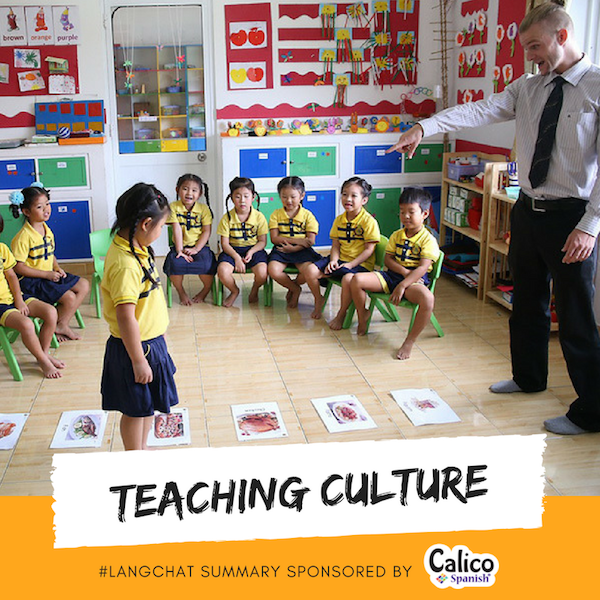Teaching Culture
 Language and culture are tightly interrelated. This week, #langchat participants took a deeper look into what it means to integrate culture into their World Language classrooms.
Language and culture are tightly interrelated. This week, #langchat participants took a deeper look into what it means to integrate culture into their World Language classrooms.
– Follow the blog on Bloglovin –
Cultural Topics that Make a Strong Unit
#Langchat teachers discussed some great cultural topics that make for strong units inside the World Language Classroom. “For Novice, something they can easily compare with their own culture” is a good way to dive into teaching new cultures (@CecileLaine). “Current events are a good starting place for me, it really depends on the students I get and their interests,” shared @rlgrandis. According to, @CatherineKU72, “food practices and products (production, distribution and consumption), fine arts (music & media) are a few of popular topics.” @MlleSulewski said, “I think the AP themes make a great cultural base for any unit in any level as well.” And @SraWilliams3 shared, “I also like to approach culture with a lense of social justice because students find it interesting and worthy of conversation.”
– Like Calico Spanish on Facebook –
Embedding Culture Across All Parts of a Unit
There are many ways in which teachers can include culture throughout an entire unit. “By creating learning activities centered around culturally-rich, comprehensible and authentic resources,” teachers can embed different cultural perspectives in their lessons (@mmeshep). “Content knowledge is key. Culture becomes naturally embedded when one knows a topic well enough to be spontaneous with it during the unit” (@Rlgrandis). @ SraWilliams3 said to “weave culture in. Start with products and practices. Observe, compare and consider perspectives.” Language and culture go hand in hand. “Culture is just as much a part of language learning and should not be taught in isolation.” (@MllesrtaUrso).
Products, Practices, and Perspectives
#Langchat participants discussed how to help their students stay focused on the three P’s- products, practices, and perspectives.
- According to @SraWilliams3, “first use the lingo with [students]. Show them products and practices. Ask why for perspective.”
- @Mr_Fernie suggests “using the resources in your own community-people, businesses, and publications.”
- @Rlgrandis uses “backwards planning with the 3 Ps in mind…have students identify and connect how the products and practices inform perspectives.”
- @MlleSulewski believes that “products get their attention. Practices get them thinking. Perspectives…now that’s where the deep learning takes place.”
- @sr_connolly said, “remember that language classes open doors to words & phrases, yes, but also to beliefs, histories, art, music and so much more.”
– Follow Calico Spanish on Twitter –
Helping Students Understand Different Cultural Practices
It is important to help students understand and respect different cultural practices. @Doriecp shared that the best way to do this is to “be a good model! Show your own attitude of curiosity when discussing cultural topics. Show your willingness to learn new things.” Begin teaching respect and understanding of different cultural practices when the students are young. @CecileLaine said, “Start with lower levels: move them away from ‘it’s weird’ to ‘it’s different and interesting.’” While teaching cultural perspectives, “point out examples of how people from other cultures have perceived something about America strange so [students] see that [perspectives] go both ways” (@Madameconrad). Be honest and transparent with students. @MmeSraResch shared, “whenever possible and appropriate, I tell stories about my experiences and mistakes.”
Introduce a child you love to a lifelong journey of speaking real Spanish to real people. Click the red button to experience it FREE.
What is one of your units that needs a cultural perspective and how can you take one step toward that?
The #Langchat discussion ended on a practical note with participants sharing how they can further integrate culture into their units and therefore instill new cultural perspectives into their students.
- @profelopez716 shared, “I’ve been working on adding more social justice pieces to units like inclusion, food, childhoods, etc. to have human connection.”
- @profe_robbins admitted, “I haven’t taught level 1 in a while. I definitely need to work on making the culture meatier.”
- @Mmeaida said, “maybe Family? Micro-level is easy but macro comparisons… what are cultural perspectives on the whole?”
- @muchachitaMJ said, “Don’t be afraid to ditch an old unit… if it doesn’t connect to kids OR target culture – change the curriculum!”
– Follow us on Instagram too! –
Thank You
Thank you to all the wonderful #langchat participants for joining in on the discussion on Teaching Culture. Thank you to our lead moderator, Elizabeth (@SraDentlinger) for guiding us!






No Comments